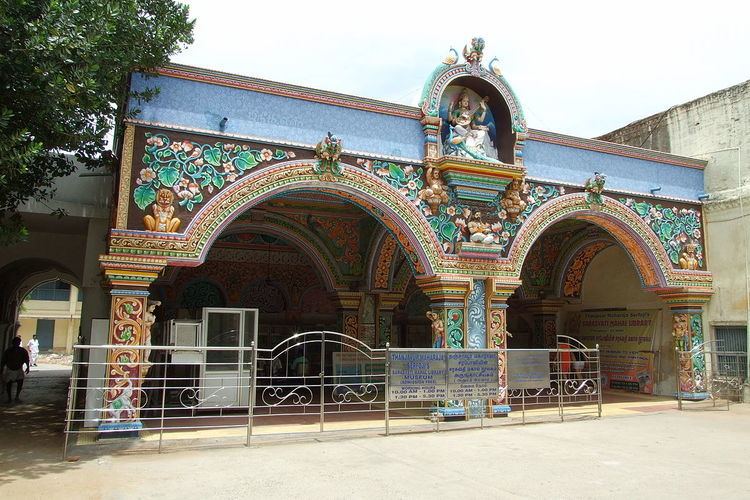Phone 04362 234 107 | Size 60,000 Items | |
 | ||
Hours Closed now Wednesday8AM–5PMThursday8AM–5PMFriday8AM–5PMSaturday8AM–5PMSunday8AM–5PMMonday8AM–5PMTuesday8AM–5PMSuggest an edit Similar Vasistesh Temple, Punnaina Sree Mariamm, Tamil University, Thirukaru Garbhara Temple, Thingalur Siva Temple | ||
Digitization of books and palm leaf manuscripts at tanjore saraswathi mahal library
Saraswathi Mahal Library or Tanjore Maharaja Serfoji's Sarasvati Mahal Library (TMSSML) is located in Thanjavur (Tanjore), Tamil Nadu, India. It is one of the oldest libraries in Asia, and has on display a rare collection of Palm leaf manuscripts and paper written in Tamil, Hindi, Telugu, Marathi, English and a few other languages indigenous to India. The collection comprises well over 60,000 volumes, though only a tiny fraction of these are on display. The library has a complete catalogue of holdings, which is being made available online. Some rare holdings can be viewed on site by prior arrangement.
Contents
- Digitization of books and palm leaf manuscripts at tanjore saraswathi mahal library
- Tv9 telugu talapatra grandha found in saraswathi mahal library at thanjavur
- History
- Efforts
- The Collection
- Some of the rare books and manuscripts
- Library Museum
- References
Tv9 telugu talapatra grandha found in saraswathi mahal library at thanjavur
History
The Saraswathi Mahal library started as a Royal Library for the private pleasure of the then Kings of Thanjavur (see, Nayaks of Tanjore) who ruled 1535 - 1675 AD. The Maratha rulers who captured Thanjavur in 1675 patronised local culture and further developed the Royal Palace Library until 1855. Most notable among the Maratha Kings was Serfoji II (1798–1832), who was an eminent scholar in many branches of learning and the arts. In his early age Serfoji studied under the influence of the German Reverent Schwartz, and learned many languages including English, French, Italian and Latin. He enthusiastically took special interest in the enrichment of the Library, employing many Pandits to collect, buy and copy a vast number of works from all renowned Centres of Sanskrit learning in Northern India and other far-flung areas.
Since 1918 the Saraswathi Mahal Library has been a possession of the state of Tamil Nadu. Its official name of the Library was changed to "The Thanjavur Maharaja Serfoji's Sarasvati Mahal Library" in honour of the great royal Marathan patron.
Efforts
The library is open to the public; it also supports efforts to publish rare manuscripts from the collection, as well as ensuring all volumes are preserved on microfilm. The Library has installed computers in 1998 for the Computerisation of Library activities. As a first phase, the Library catalogues are being stored in the Computer for easy information retrieval. It is also proposed to digitalise the manuscripts of this Library shortly.
The Collection
The bulk of the manuscripts (39,300) are in Sanskrit, written in scripts such as Grantha, Devanagari, Nandinagari, Telugu. Tamil manuscripts number over 3500000, comprising titles in literature, music and medicine. The Library has a collection of 3076 Marathi manuscripts from the South Indian Maharastrian of the 17th, 18th, and 19th centuries; this includes the hierarchy of the Saints of Maharashtra belonging to Sri Ramadasi and Dattatreya Mutts. The Marathi manuscripts are mostly on paper but a few were written in Telugu script on palm-leaf. There are 846 Telugu manuscripts in the holdings, mostly on palm leaf. There are 22 Persian and Urdu manuscripts mostly of 19th century also within the collection. The library also holds medical records of Ayurveda scholars, including patient case studies and interviews in the manuscripts classified under the Dhanvantari section.
Apart from these manuscripts there are 1342 bundles of Maratha Raj records available at the Library. The Raj records were written in the Modi script (fast script for Devanagari) of the Marathi language. These records encompass the information of the political, cultural and social administration of the Maratha kings of Thanjavur.
Some of the rare books and manuscripts
Library Museum
A museum is located in the Library building to reveal the importance of the Library to the Public. This Museum is small but organised into sections highlighting ancient Manuscripts, Illustrated Manuscripts, Printed copies of the Original Drawings, Atlases, Thanjavur- style Paper Paintings, Canvass Paintings, Wooden Paintings, Glass paintings, Portraits of the Thanjavur Maratha kings, and the Physiognomy charts of Charles Le-Brun. These materials give an idea of the total variety in the vast collection within the Library.
The Saraswati Library is situated within the campus of the Thanjavur Palace. Visitors can have a glimpse of preserved books and can sit and read in the library premises. Better preservation of books and facilities like air-conditioning with dehumidifiers, redesigning of space for comfortable reading, online catalogue facility should be taken up to preserve this internationally renowned treasure trove of books and palm-leaf manuscripts !
Efforts were made to microfilm and catalogue the contents way back in 1965 when Indira Gandhi was Information and Broadcasting Minister, Government of India who sanctioned the fund for the library's development. Since then no efforts were made to scan the documents and computerise the same using present day technology. It is also a designated 'Manuscript Conservation Centre' (MCC) under the National Mission for Manuscripts established in 2003.
